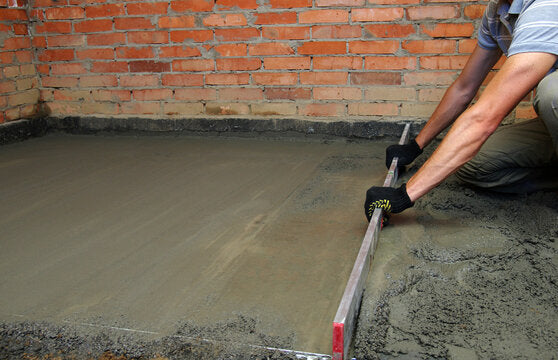The most common types of screed include:
Bonded Screed
The screed layer is fully bonded to the substrate using a primer or bonding agent. This method is commonly used for thinner screeds where heavy loading is expected and where there is not enough space available to lay an un-bonded screed. The optimum thickness of a sand and cement bonded screed is generally in the region of 25-40 mm. Some calcium sulphate flowing screeds can be laid at a minimum depth of 12 mm. Care must be taken during the laying process to ensure de-bonding does not occur as this can lead to instability and ultimately, the screed may fail.

Un-bonded Screed
Instead of being bonded directly to the base, un-bonded screeds are applied over a damp proof membrane (DPM) laid on top of the concrete base. The minimum thickness of an unbonded sand and cement screed is usually in the region of 50 mm. Calcium Sulphate screeds can be laid un-bonded at a minimum depth of 30 mm. The advantage of an un-bonded screed is that the flooring is not in direct contact with the main structure and so the potential impacts of settlement or shrinkage can be less problematic. The DPM creates a barrier preventing damp rising from the substrate.
However, this type of screed can be more prone to curling if dried quickly. Curling is a vertical distortion of the edges due to temperature differences or moisture content throughout the thickness of the screed. This can be prevented by adhering to minimum specified thicknesses and allowing for slow drying. Calcium Sulphate screeds are not prone to curling due to their lower rates of shrinkage compared to sand and cement screeds.

Floating Screed
The screed is laid on top of insulation to create a thermally efficient floor. Floating screeds are commonly used where underfloor heating systems are provided or thermal or acoustic insulation is required. Floating sand and cement screeds generally have a thickness greater than 65 mm for lightly-loaded floors and 75 mm for more heavily-loaded floors. Calcium Sulphate floating screeds can be installed at 35 mm depth for domestic use or 40 mm for commercial use.

Flow/liquid Screed
Liquid flow screed is fast becoming the industry standard in floor screeds. This type of floor is also referred to as self compacting screed or a calcium sulphate screed. Simple in its preparation this new form of flow screed is suitable for light foot traffic in 24-48 hours. Partitions can be installed and/or the screed can be loaded out 7 days after installation.
Screed over Underfloor Heating
This is where the floating screed layer is installed over underfloor heating pipes or insulation. The screed serves to conduct the heat evenly across the floor surface, avoiding hot or cold spots, and helps to retain heat for longer. In order that heat propagates only in the required direction of the room to be heated or cooled, the elements are inserted above insulating panels. Sand cement screeds require a minimum thickness of 65 mm, with the ideal being between 65-75 mm.
Where fibres are added or when using anhydrite screeds the minimum thickness may be reduced to 50 mm. Some specialised calcium sulphate screeds can be installed with only 20 mm cover to the heating pipes, giving screed depths of less than 40 mm.
Care must be exercised in allowing adequate drying time (usually around 21 days) before incrementally turning on the heating system, otherwise cracking may occur. Additives can be included in the screed mix to allow the drying time to be reduced. Calcium sulphate screeds can be force dried, using the underfloor heating, after 7 days.
All types of screed should have the underfloor heating run through a heating/cooling cycle before floor coverings of any type are installed.

Composition of Screed
Most screeds are made from a 1:3 to 1:4.5 ratio of cement to sand. Enhanced screeds include additives to improve the properties of the standard screed. This can allow for faster drying times and extra strength if required.
Manufacturers also offer self-compacting screeds that can be pumped through a delivery hose and levelled with a dappling bar. The majority of these screeds are anhydrite compounds based on a calcium sulphate binder. Large areas can be covered more quickly, however, care must be taken to ensure this type of screed dries completely. Calcium sulphate screeds cannot be laid to a fall and are not suitable for permanently wet areas such as wet rooms, saunas, steam rooms and swimming pool surrounds.
All screeds expand and contract to some degree so large areas need to have expansion joints or crack inducer cuts in the screed to allow movement without cracking.




